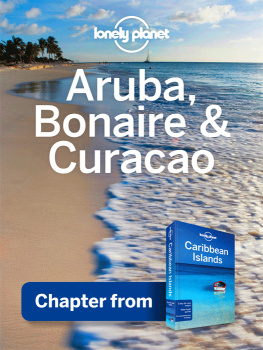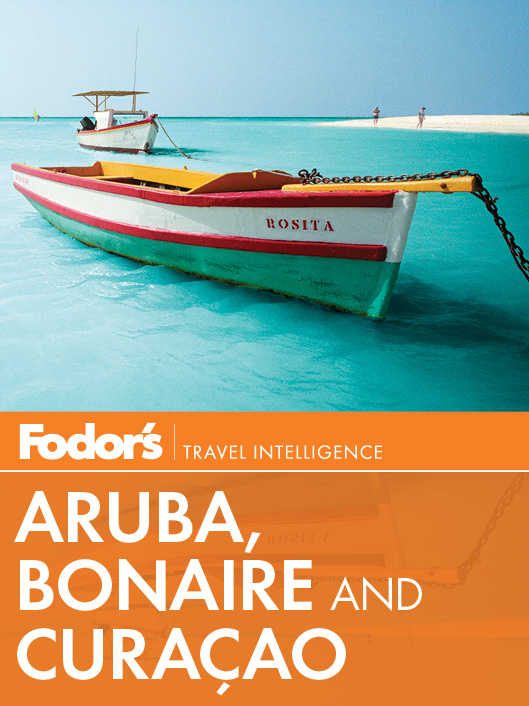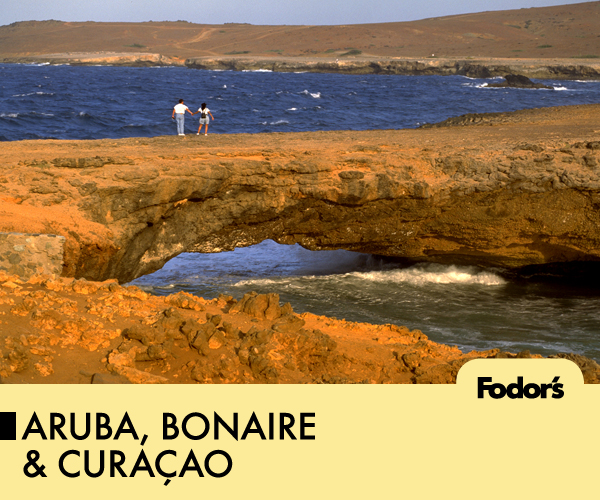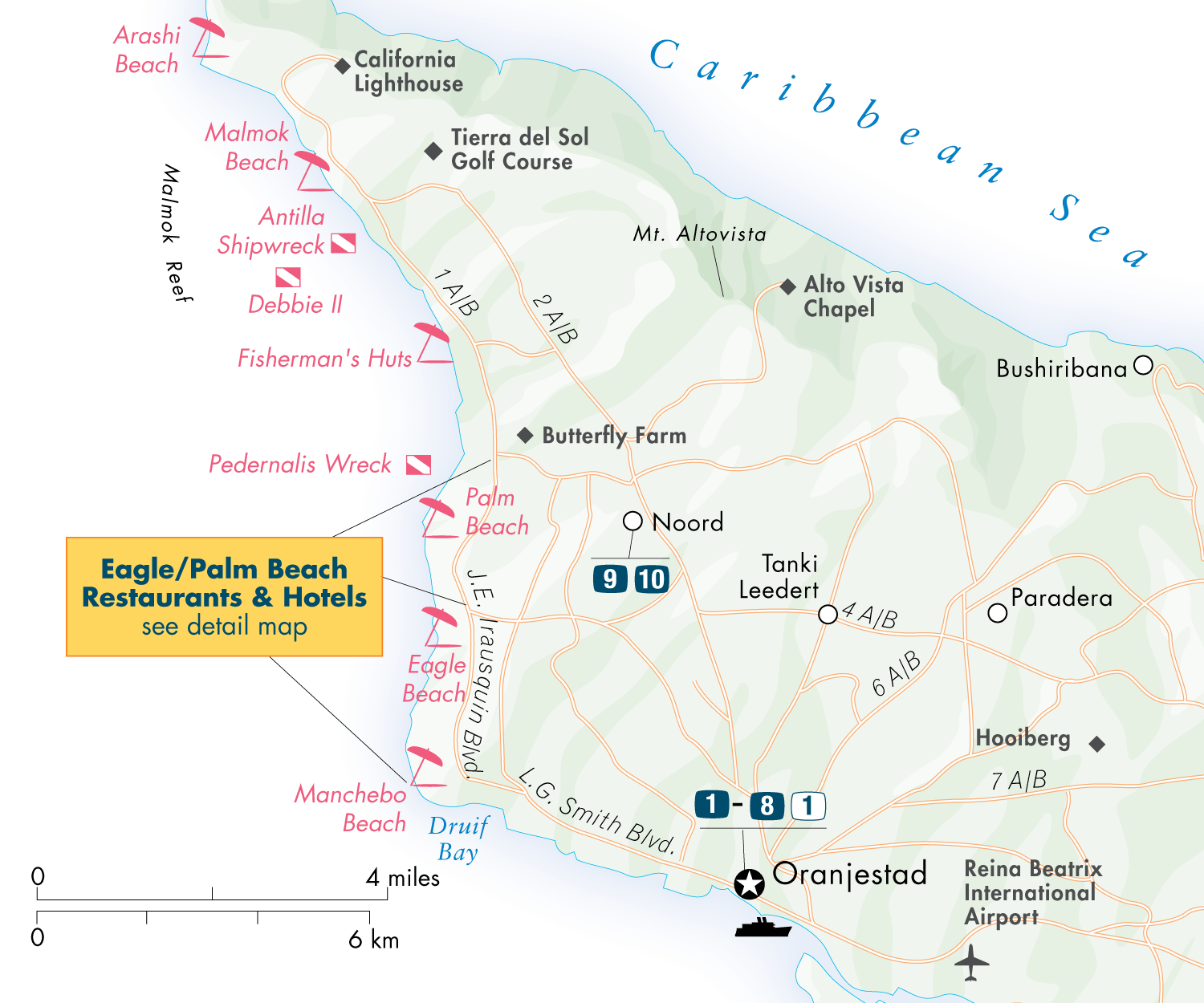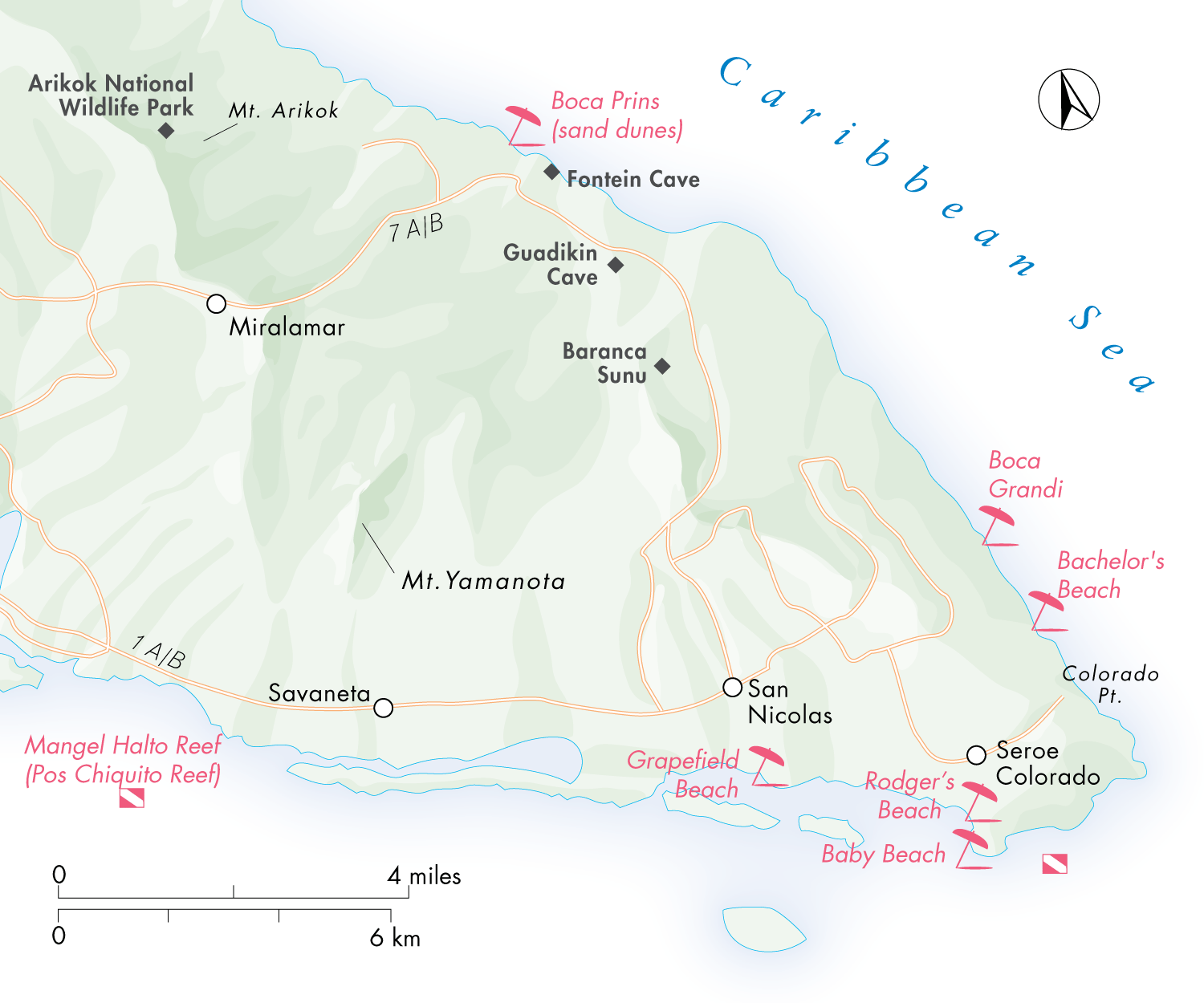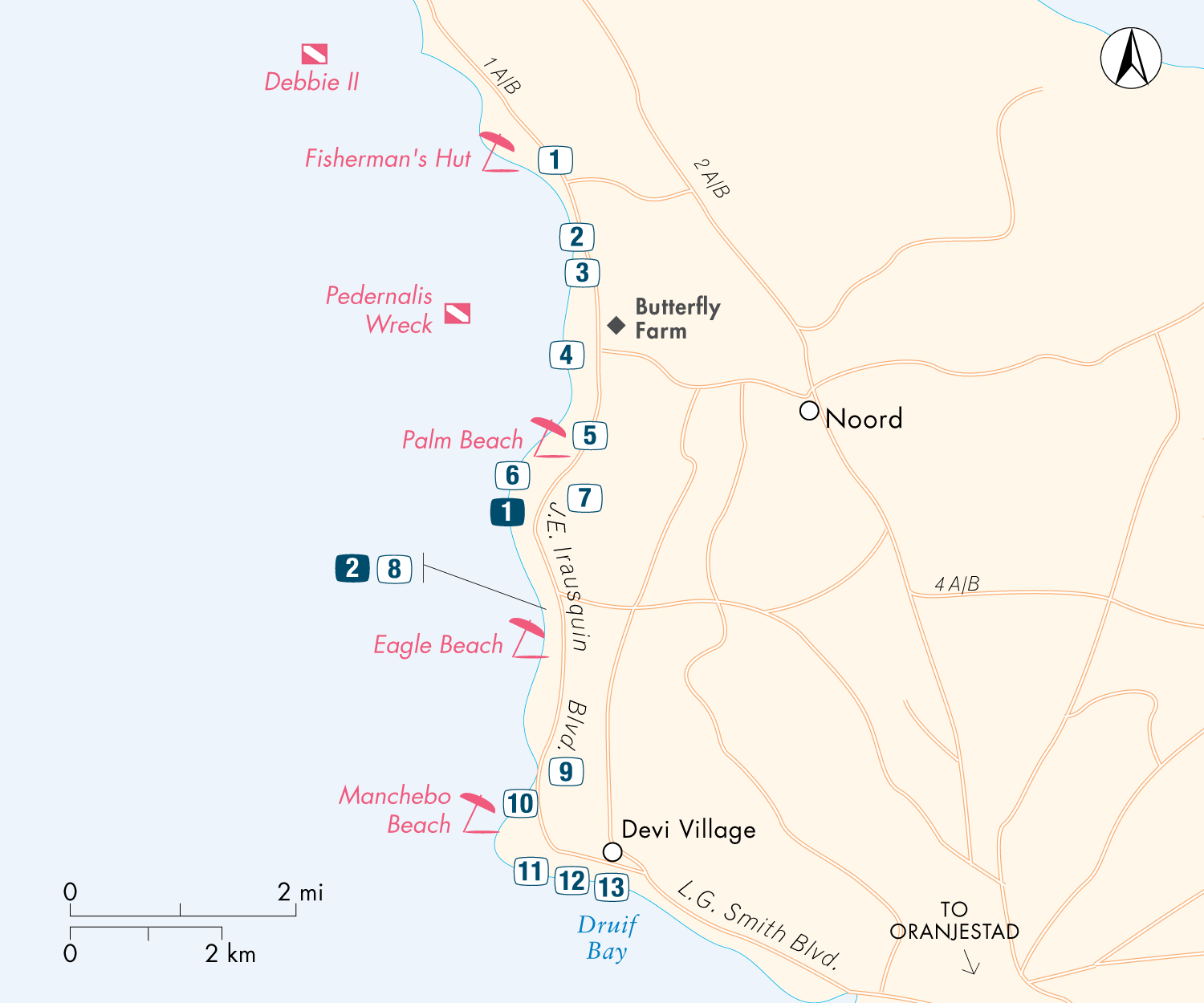WELCOME TO ARUBA
Cruise ships gleam in Oranjestad Harbour, and thousands of eager tourists scavenge through souvenir stalls looking for the perfect memento. The mile-long stretch of L.G. Smith Boulevard is lined with cafs, designer stores, and signs for the latest Vegas-style shows. The countryside is dotted with colorful cunucu (country-style houses) and small neighborhood shops. Suddenly, the rocky desert landscape is startlingly austere.
Aruba offers an amazingly diverse experience in a small package. Tourists flock here for the sunny climate, perfect waters, and excellent beachesso much so that the area around beautiful Eagle Beach is an almost unbroken line of hotels, restaurants, and bars. Here on the south coast, the action is nonstop both day and night, whereas the fiercely rugged north coast is a desolate and rocky landscape that has so far resisted development.
As with Bonaire and Curaao, the island was originally populated by the Caquetio, an Amerindian people related to the Arawak. After the Spanish conquered the island in 1499, Aruba was basically left alone, since it held little agricultural or mineral appeal. The Dutch took charge of the island in 1636, and things remained relatively quiet until gold was discovered in the 1800s.
Like the trademark watapana (divi-divi) trees that have been forced into bonsailike angles by the constant trade winds, Aruba has always adjusted to changes in the economic climate. Mining dominated the economy until the early part of the 20th century, when the mines became unsustainable. Shortly thereafter, Aruba became home to a major oil-refining operation, which was the economic mainstay until the early 1990s, when its contribution to the local economy was eclipsed by tourism. Today, after being so resolutely dedicated to attracting visitors for so many years, Arubas national culture and tourism industry are inextricably intertwined.
With more than half a million visitors a year, Aruba is not a destination that will appeal to those trying to avoid the beaten pathbut you should visit Aruba if youre looking for a pleasant climate, excellent facilities, lots of nightlife, and no surprises. The U.S. dollar is accepted everywhere, and English is spoken universally, which makes Aruba a popular spot for Americans who want an overseas trip to a place that doesnt feel foreign. In fact, Americans go through U.S. customs right at the airport in Aruba, so there are no formalities upon landing in the United States.
TOP ATTRACTIONS
Nightlife is among the best in the Caribbean. The colorful Kukoo Kunuku party bus picks you up and pours you out at your hotel.
Powder-soft beaches and turquoise waters are legendary.
Great restaurants offer a wide range of cuisine as good as any in the Caribbean.
Arubas casinos will please both casual and serious gamblers.
A friendly population devoted to tourism guarantees welcoming smiles throughout the island.
GETTING ORIENTED
The A in the ABC Islands (followed by Bonaire and Curaao), Aruba is smallonly 19 mi (31 km) long and 6 mi (9 km) across at its widest point. It became an independent entity within the Netherlands in 1986. The official language is Dutch, but almost every native speaks English and Spanish as well. The islands population is 104,000.
Restaurants
Hotels
Beaches
Beaches
Restaurants
Hotels
ARUBA PLANNER
DRIVING TIPS
International traffic signs and Dutch-style traffic signals (with an extra light for a turning lane) can be misleading if youre not used to them; use extreme caution, especially at intersections, until you grasp the rules of the road. Speed limits are rarely posted but are usually 50 mph (80 kph ) in the countryside. Aside from the major highways, the islands winding roads are poorly marked. Gas prices average about $1.10 a liter (roughly 1/3 gallon), which is reasonable by Caribbean standards.
LANGUAGE TIPS
Everyone on the island speaks English, but the official languages are Dutch and Papiamento. Most locals speak Papiamentoa fascinating, rapid-fire mix of Spanish, Dutch, English, French, and Portuguesein normal conversation. Here are a few helpful phrases: bon dia (good day), bon nochi (good night), masha danki (thank you very much).
GETTING TO ARUBA
Hassle Factor: Low.
Nonstops: There are nonstop flights from Atlanta (Delta), Boston (American, JetBlue, US Airways), Charlotte (US Airways), Chicago (Unitedweekly), Fort Lauderdale (Spiritweekly), Houston (Continentaltwice weekly), Miami (American), Newark (Continental), New YorkJFK (American, Delta, JetBlue), New YorkLGA (Continentalweekly), Philadelphia (US Airwaystwice weekly), and Washington, D.C.Dulles (United), though not all flights are daily.
Air Travel: Many airlines fly nonstop to Aruba from several cities in North America; connections will usually be at a U.S. airport. Smaller airlines connect the Dutch islands in the Caribbean, often using Aruba as a hub. Travelers to the United States clear U.S. Customs and Immigration before leaving Aruba.
The islands state-of-the-art Reina Beatrix International Airport (AUA) is equipped with thorough security, many flight displays, and state-of-the-art baggage-handling systems.
American Airlines
( 297/5822700 on Aruba; 800/4337300 | www.aa.com ).
Continental Airlines
( 297/5880044 on Aruba; 800/5233273 for U.S. and Mexico reservations; 800/2310856 for international reservations | www.continental.com ).
Delta Airlines
( 297/5880044 on Aruba; 800/2211212 for U.S. reservations; 800/2414141 for international reservations | www.delta.com ).
Dutch Antilles Express
( 599/7170808 | www.flydae.com ).
JetBlue
( 800/5382583 | www.jetblue.com ).
KLM
( 297/5823546 on Aruba; 31/204747747 in Amsterdam | www.klm.com ).
Northwest Airlines
( 800/2252525 | www.nwa.com ).
Spirit Airlines
( 800/7727117 or 586/7917300 | www.spiritair.com ).
United Airlines
( 297/5886544 on Aruba; 800/5382929 in North America | www.united.com ).
US Airways
( 297/8001580 on Aruba; 800/4284322 for U.S. and Canada reservations; 800/6221015 for international reservations | www.usairways.com ).
GETTING AROUND ARUBA
Bus Travel: Buses run hourly trips between the beach hotels and Oranjestad. The one-way fare is $1.25 ($2.25 round-trip), and exact change is preferred (so be sure to keep some U.S. change handy if you plan to pay in U.S. currency). There are also minibuses that will pick you up at the same stops for the same price; just be sure to look for the ata approved sign. Buses also run down the coast from Oranjestad to San Nicolas for the same fare.
Car Travel: If you want to explore the countryside and try different beaches, then you should rent a car. Try to make reservations before arriving, and rent a four-wheel drive if you plan to explore the islands natural sights. For just getting to and around town, taxis are preferable, and you can use tour companies to arrange your activities.


